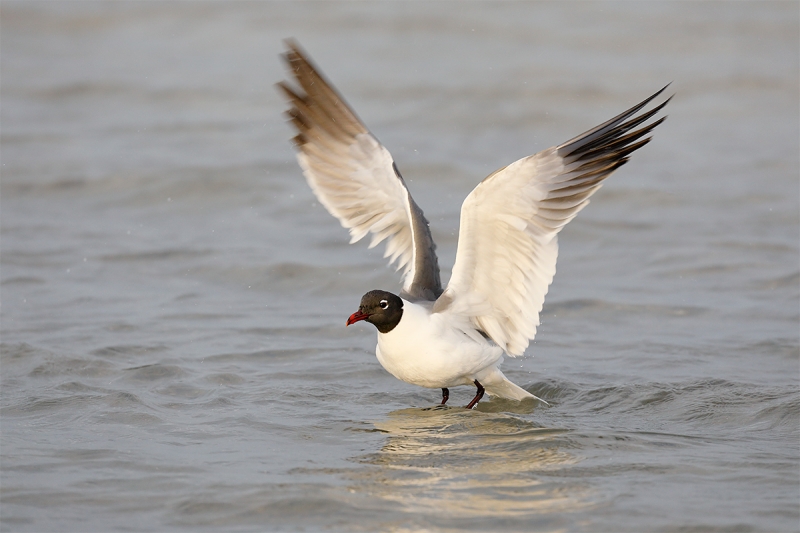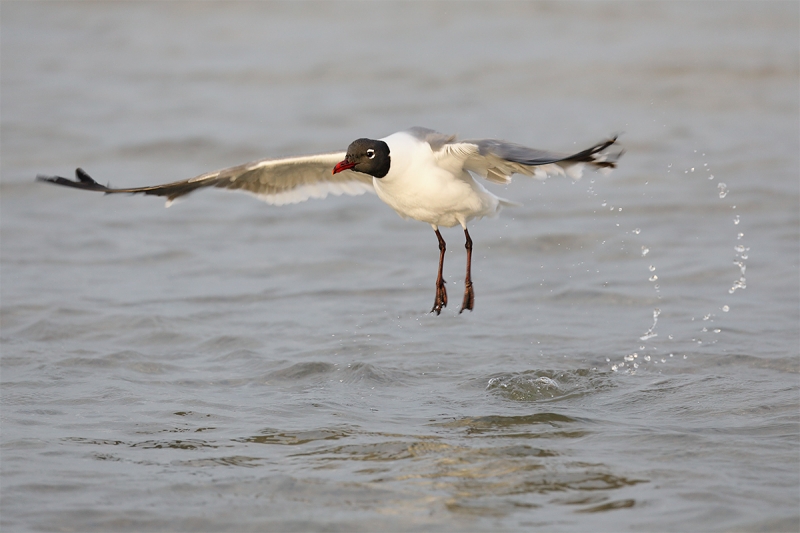What’s Up?
Finland has continued to amaze. On Thursday we enjoyed photographing battling Black Grouse on their lekking grounds for the second straight morning. On pure snow. That afternoon was diving Ospreys and an hour with a crazy Capercaillie … We had a killer morning with a pair of White-throated Dippers on Friday and a great feeder set-up session on Friday afternoon: Bullfinch, Greenfinch, both Great and Blue Tits, and Great Spotted Woodpecker! We head up to Oulu on Saturday to try for Ruff …
Be Sure!
Be sure to check out David Hollander’s Fort DeSoto IPT gallery here. All were made with “only” his 100-400 II!
Gear Questions and Advice
Too many folks attending BAA IPTs and dozens of folks whom I see in the field, and on BPN, are–out of ignorance–using the wrong gear, especially when it comes to tripods and more especially, tripod heads… Please know that I am always glad to answer your gear questions via e-mail.
Please Don’t Forget …
As always–and folks have been doing a really great job for a long time now–please remember to use our B&H links for your major and minor gear purchases. For best results, use one of our many product-specific links; after clicking on one of those you can continue shopping with all subsequent purchases invisibly tracked to BAA. Your doing so is always greatly appreciated. Please remember: web orders only. And please remember also that if you are shopping for items that we carry in the BAA Online Store (as noted in red at the close of this post below) we would of course appreciate your business.
|
|
|
This image was created on the 2017 DeSoto Spring IPT with the hand held Canon EF 100-400mm f/4.5-5.6L IS II USM lens, the Canon Extender EF 1.4X III (at 463mm) and my favorite bird photography camera body, the Canon EOS 5D Mark IV. ISO 800. Evaluative metering at zero: 1/800 sec. at f/8 in Manual mode. AWB LensAlign/FocusTune micro-adjustment: 0. One AF point below the center AF point/AI Servo/Expand/Shutter Button AF was active at the moment of exposure. The selected AF point was on the bird’s head when the shutter was released. Image #1: Laughing Gull flapping after bath |
Bathing Bird Tips
When you see a bird dipping its breast in the water, nine times out of ten it will flap in place after its bath. Sometimes they will jump up and flap. Note that in Image #1 I moved the AF point down one row to allow for the raised wings. Once you are sure you have a bathing bird you have a very important choice to make. Do you move (or zoom) in for a tight shot splashing shot or move back or zoom out for the flap? Both can be spectacular but I will admit that more times than not I will try to get to a focal length that will allow me to get the flap without clipping the wings.
The greatest challenge is keeping the AF point on the bird’s head or upper breast when it jumps up after or while flapping after the bath …
Note: you should always be working in Manual mode when photographing bathing birds as the often-white underwings will influence the meter toward underexposure when the flap comes …
100-400II/1.4XIII TC/5D IV Versatility
When working with relatively tame subjects the 100-400II/1.4XIII TC combo is the ultimate bathing bird set-up. (Note: with a 7D II, you usually will not need the TC.) In any case, you will clip far fewer wingtips by zooming out well in advance and the 100-400 II allows you to do just that with ease. It is always better to lean toward a more conservative zoom out than to risk clipping those wings … Not to mention that when hand holding it is much easier to get into position than it is when working off the tripod.
Dull Day Image Optimization Tip
When photographing on dull days in flat light, try adding a layer of Auto Contrast and then reducing the opacity of the layer to somewhere between 50 and 20%. Doing so will give your images much more pop.
|
|
|
This image was created on the 2017 DeSoto Spring IPT with the hand held Canon EF 100-400mm f/4.5-5.6L IS II USM lens, the Canon Extender EF 1.4X III (at 463mm) and my favorite bird photography camera body, the Canon EOS 5D Mark IV. ISO 800. Evaluative metering at zero: 1/800 sec. at f/8 in Manual mode. AWB LensAlign/FocusTune micro-adjustment: 0. One AF point below the center AF point/AI Servo/Expand/Shutter Button AF was active at the moment of exposure. The selected AF point was on the bird’s head when the shutter was released. Image #2: Laughing Gull flying off after bath |
Ineptitude Pays Off!
Ideally, I would have tracked the gull as it lifted off and flew to my left and kept the selected AF point somewhere on the bird’s head or neck. Had I done that and “properly” framed the image, I would have cut the two lovely circular splashes in half. Though the selected AF point was positioned to the left of the bird’s right foot the system did not search for an focus on the water. It stayed fairly accurately with the bird. Why? My custom case 3 settings tell the AF system not to react quickly when the active AF point falls off the subject. My custom case III settings are detailed in all of the BAA Camera User’s Guides here. Note: I just began work on a 5D Mark IV User’s Guide.
|
DeSoto in spring is rife with tame and attractive birds. From upper left clockwise to center: breeding plumage Dunlin, dark morph breeding plumage Reddish Egret displaying, breeding plumage Laughing Gull/front end vertical portrait, breeding plumage Laughing Gull with prey item, Laughing Gull on head of Brown Pelican, screaming Royal Tern in breeding plumage, Royal Terns/pre-copulatory stand, Laughing Gulls copulating, breeding plumage Laughing Gull/tight horizontal portrait, Sandwich Tern with fish, and a really rare one, White-rumped Sandpiper in breeding plumage, photographed at DeSoto in early May. |
BIRDS AS ART May 20-21 Fort DeSoto In-the Field Instructional Meet-Up Sessions
Join me in Tierra Verde, FL for all or part of the weekend of May 20-21, 2017. Beginners are welcome. Lenses of 300mm or longer are recommended but even those with 70-200s should get to make some nice images. Teleconverters are always a plus. You will learn the basics of digital exposure and image design, autofocus basics, and how to get close to free and wild birds. We should get to photograph a variety of wading birds, shorebirds, terns, and gulls. These inexpensive sessions are designed to give folks a taste of the level and the quality of instruction that is provided on BIRDS AS ART Instructional Photo-tours. I hope to meet you there.
May 20-21, 2017 Schedule
- Saturday May 20 Meet-up Morning: 6:30 till 10:00am: $99.
- Lunch and Image Review: $99.
- Saturday afternoon: 4pm till sunset: $99.
- Sunday May 21 Meet-up Morning, Meet-up Morning: 6:30 till 10:00am: $99.
Cheap Canon lens rentals available: 600 II, 500 II, 400 DO II, or 200-400.
To pay for one or more sessions in full via credit card, call Jim or Jen in the office weekdays at 863-692-0906. You will be responsible for the cost of your Gatorland Photographer’s pass or passes. Please shoot me an e-mail with questions.
Please Remember to use my Affiliate Links and to Visit the New BAA Online Store 🙂
To show your appreciation for my continuing efforts here, we ask, as always, that you get in the habit of using my B&H affiliate links on the right side of the blog for all of your photo and electronics purchases. Please check the availability of all photographic accessories in the New BIRDS AS ART Online Store, especially the Mongoose M3.6 tripod head, Wimberley lens plates, Delkin flash cards and accessories, and LensCoat stuff.
As always, we sell only what I have used, have tested, and can depend on. We will not sell you junk. We know what you need to make creating great images easy and fun. And please remember that I am always glad to answer your gear questions via e-mail.
I would of course appreciate your using our B&H affiliate links for all of your major gear, video, and electronic purchases. For the photographic stuff mentioned in the paragraph above, and for everything else in the new store, we, meaning BAA, would of course greatly appreciate your business. Here is a huge thank you to the many who have been using our links on a regular basis and those who will be visiting the New BIRDS AS ART Online Store as well.
Be sure to like and follow BAA on Facebook by clicking on the logo link upper right. Tanks a stack.
Typos
In all blog posts and Bulletins, feel free to e-mail or to leave a comment regarding any typos or errors. Just be right :).

















Thanks for that. I’m new to Canon’s best and was expecting too much. And to boot I was using 400 DO II X2 III at F8. Guess I need my head examined!
Jack
Yes D500 is a 1.5x Crop Body and hence I am going to use 70-200 f/4 + 1.4xTC to get equivalent to 100-400 lens. Additionally I am going to use 300mm f/4 PF lens its very light and perfect with close focusing. I thinking about using it for flight Photography. I will be purchasing it shortly using your B&H Links… 🙂
Good plan and many thanks. Be sure to send me your B&H receipt via e-mail.
with love from Finland,
artie
With “quick” birds such as smaller song birds I have concluded that where the AF point resides is kind of meaningless because the AF acquisition time is simply not enough for an accurate focus to have occurred. This is my conclusion after many hours of attempting shots of juncos jumping and fighting mid air just above a feeding area (1DX2 Case 6). I have many photos with the AF point showing it was perfectly placed and the result is OOF. For Sony’s new A9 they are “bragging” an AF acquisition of 1/60 sec., which would be under most ideal conditions.
So Artie, my question is, what have you found relative to this situation? Have you obtained consistent AF on small birds that are not being tracked (virtual impossibility) as they do their unpredictable antics? A bird rising off the water would strike me as being well within the AF capability. Also, do you have any suggestion relative to fine tuning the parameters?
Jack
Yes, what you are describing is pretty much impossible with the currently available gear. 99.99999% of songbird flight photography is done at feeders in one of two ways: with multi-flash set-ups and electronic triggers or by pre-focusing and blasting aways thousands of times till you get one in focus.
All of our Camera User’s Guides contain the AF settings (including my Custom Case) that I have set on all of my cameras. None of them will help you AF with small songbirds in flight.
with love, artie
Beautiful Images.
Indeed 100-400 f/4-5.6 Lens is a great combination. I am going to use 300mm f/4 + 70-200mm f/4 combination of lenses to achieve the same.
Thank you for the great info provided in the Blog.
YAW and thank you. The zooms are great and if I remember your D-500 is a 1.5 crop body …
with love, artie